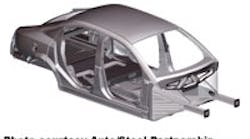Roger Heimbuch remembers a time when he could identify every grade of steel on every square inch of any car he saw on a street.
That was 10 years ago. Today, Heimbuch is still immersed in steel as the director of the Auto/Steel Partnership, an organization dedicated to developing and using advanced steels on cars and trucks. But what's changed is that new materials, such as advanced high-strength steels (AHSS), are appearing in more and more places -- at a more rapid pace than ever before.
New materials, from advanced high-strength steel, to nickel-based alloys, to carbon fibers and triple nickel titanium, are finding ways into new applications, offering combinations of properties and cost advantages once previously believed to be impossible.
The body structure of a vehicle designed by The Auto/Steel Partnership for a New Generation of Vehicles uses advanced light weight steel to create more fuel
efficient cars.
Perhaps the single most dominant trend in new materials, says Jon Riley, executive director, design & engineering programs at NCMS, is more materials are being tailored in development to very specific end-use applications through simulation software.
"If you look at it like an equalizer on a stereo, you have all these little levers that go up and down," says Riley. "Well, in material development you have 1,001 material properties and processing parameters that you can simulate. One lever goes up and another goes down, and you try to meet requirements in minimum material density and at the lowest material processing cost."
In advanced high-strength steel, which is appearing more frequently in cars today, there are islands of martensite in a matrix of ferrite.
"In the 1980s, we used mild steels with zinc coatings to prevent corrosion, and in the 1990s we started to develop high-strength, low-alloy steels," says Dave Anderson, director of the Automotive Applications Council for the American Iron and Steel Institute. "But what we like about AHSS is that you can form that easily because of the soft ferrite phase, but it gives you strength and stiffness because of the martensite. You get both good formality, but also strength."
In other industries and applications, weight isn't nearly as important as the material properties and how they respond to different environments.
At GE Energy, Bryan Dodds, manufacturing technology leader for the global supply chain organization, works primarily with steam and gas turbines for the power-generation industries. Dodds has seen nickel-based alloys emerge as a result of needing a material that can withstand temperatures of up to 2,200 degrees Fahrenheit.
Dodds came to GE Energy after spending the bulk of his career at Boeing and witnessed the explosion of carbon composites in aerospace. The same thing, he says, is happening today in wind energy -- as blade manufacturers are faced with manufacturing obstacles.
"Today, what I see out of the blade manufacturing are the practices that were used 10 to 15 years ago in aerospace," says Dodds. "Even though the materials are different and the product and strength requirements are different, the manufacturing processes overlap quite a bit. I see with the blade manufacturing a lot more automation being introduced in the next five years to drive product consistency and quality, but also to hit the targets we have for renewable energy."
The compressor section inside GE Energy's gas turbines is made largely from nickel-based alloys, a material that can withstand temperatures of up to 2,200 degrees Fahrenheit.
"The speed of new materials is absolutely increasing, but so is the complexity," says Mehta. "I think the things that are pushing the development are the necessity for green, recyclability and a lower weight. But our needs for performance requirements are going up with it too."
See Also



